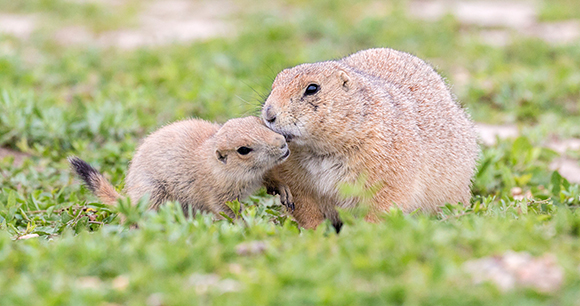Protecting Prairie Dogs from Plague
The diminutive prairie dog plays an outsized role in the prairie ecosystem. As vital prey for some species and habitat creators for others through their complex system of burrows, they support approximately 150 other species, including endangered black-footed ferrets, burrowing owls, prairie rattlesnakes, horned larks, ferruginous hawks, and bobcats. Ecosystem services provided by prairie dogs include recharging groundwater, aerating soil, sequestering carbon, cycling nutrients, spreading seeds, preventing desertification, and creating fire breaks.

Prairie dog “towns” are divided into neighborhoods, with families maintaining a tight-knit structure and close community ties. Prairie dogs collaborate on collecting food, groom each other, and are often observed affectionately hugging and playing. They also have what is believed by many to be the most sophisticated language system of all nonhuman animals.
Despite their important role, populations of the five prairie dog species have declined by around 95 percent—with two listed under the Endangered Species Act—due to a variety of threats, including habitat destruction and eradication efforts through shooting and poisoning campaigns. Sylvatic plague (introduced to North America around 1900) also poses a grave danger to these animals, with up to 98 percent mortality in affected colonies.
AWI is partnering with the Humane Society of the United States on emergency disease mitigation in South Dakota’s Conata Basin, home to the world’s largest remaining colony of black-tailed prairie dogs. Earlier this year, plague resurfaced in this population after a 20-year absence, with devastating effects. AWI is supporting the HSUS’s deployment of the best solution available—a prophylactic to control fleas that transmit the disease. This effort will save the lives of over 200,000 prairie dogs plus the myriad associated animals who rely on them.
Program Terms: Terrestrial Wildlife
AWI Quarterly Terms: Quick Read
Related News
IUCN Reaffirms Long-Tailed Macaques’ Endangered Status Despite Industry Pressure
In Program: Terrestrial WildlifeThe International Union for Conservation of Nature (IUCN) today released an update to its Red List of Threatened Species. The update revealed that the long-tailed...
AWI Funds Research to Alleviate Human-Wildlife Conflicts, Animal Suffering
In Program: Terrestrial WildlifeThe Animal Welfare Institute (AWI) announced today the eight recipients of its Christine Stevens Wildlife Award who are developing humane solutions to human-wildlife conflicts and...
Refuge from Cruel Trapping Act Reintroduced to Protect Wildlife and Pets on Public Lands
In Program: Companion Animals, Terrestrial WildlifeThe Animal Welfare Institute (AWI) endorses the Refuge from Cruel Trapping Act, reintroduced today in the US House of Representatives by Rep. Jerrold Nadler (D-NY)....
Colorado Now Leads Country in Comprehensive Approach to Fighting Wildlife Trafficking
In Program: Terrestrial WildlifeToday, Colorado Gov. Jared Polis signed S.B. 25-168 into law to combat wildlife trafficking. The bipartisan legislation, which is unique among states for the number...